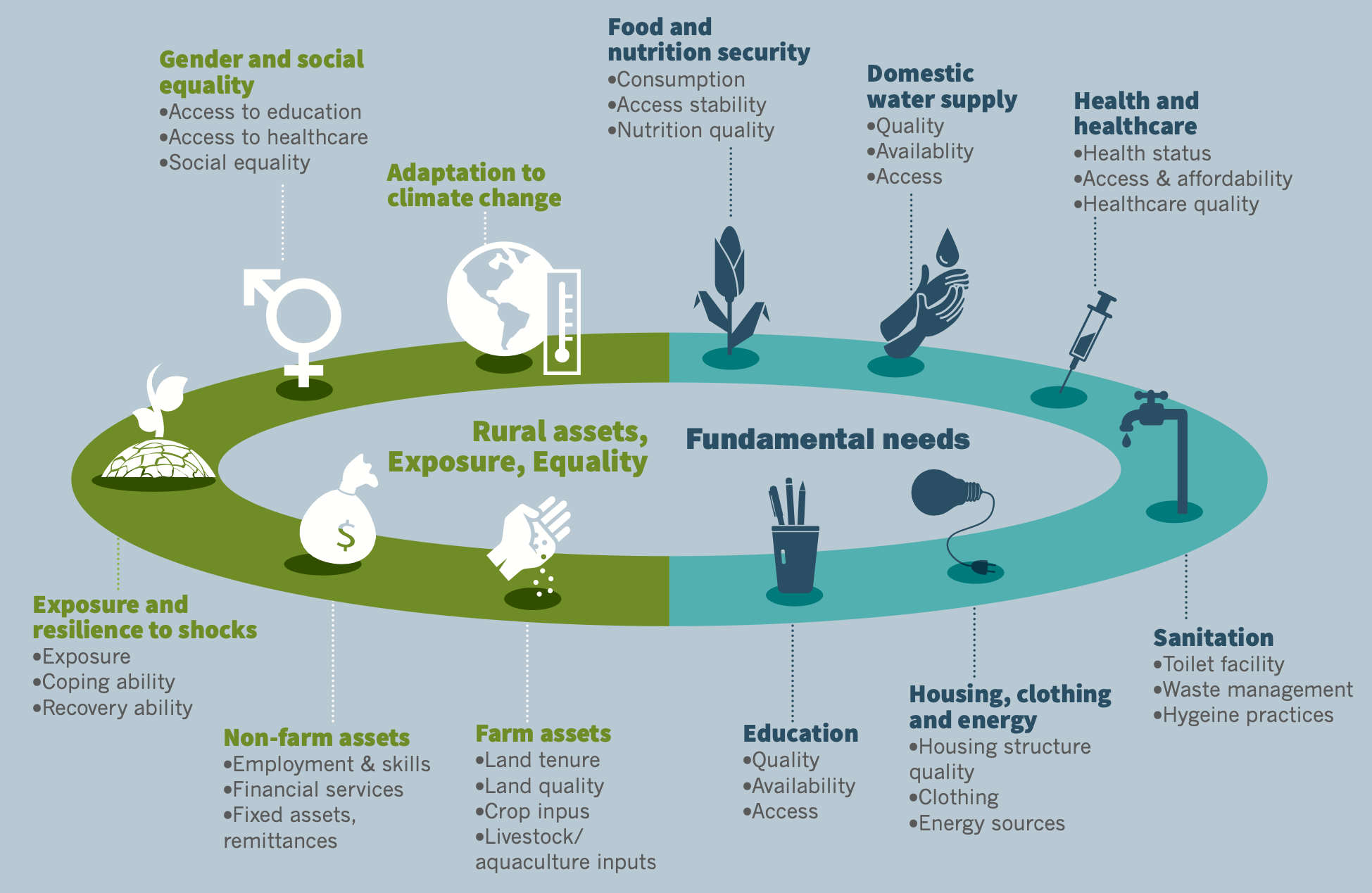Perceptions of poverty: Evaluating Multidimensional Poverty Assessment Tool derived rankings and global development indicators in five African nations
Authors: Minjauw, F., Rasheduzzaman, M., Baumgartner, P., Doward, P., Clarkson, G., & Cohen, A.*
Publication Year: 2024 | Journal / Publisher: Journal of International Development
Abstract/Summary: This study assessed an array of indicators for rural poverty assessments and evaluated use of the Multidimensional Poverty Assessment Tool (MPAT) as a proxy for commonly used indicators, such as the Human Development Index, Gross National Income, Global Hunger Index, and the Gender Inequality Index. MPAT data from 5322 rural households across five countries in Africa were analyzed. While MPAT aligned well with development indicators for Kenya, Lesotho, and Tanzania, this was not the case for Eswatini and Zimbabwe. Overall, MPAT-based rankings correlated well with hunger, food security, and gender equality indicators. Our findings highlight the use of MPAT-derived indices as valuable supplements for commonly used development indicators.
PDF on Publisher Website | PDF on OSF
Quantifying the qualitative: Eliciting expert input to develop the Multidimensional Poverty Assessment Tool
Authors: Cohen, A. & Saisana, M.
Publication Year: 2014 | Journal / Publisher: Journal of Development Studies
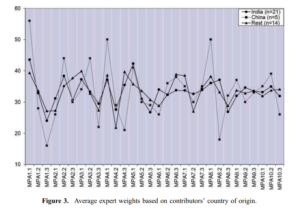 Abstract/Summary: This article discusses the participatory creation of the Multidimensional Poverty Assessment Tool (MPAT), a survey-based thematic indicator developed in China and India. The core of the article focuses on the use of expert elicitation to inform the construction of MPAT’s household and village surveys, the cardinalisation of survey responses, and the weighting scheme design. This is followed by a discussion of the potential pitfalls of expertise in development, the decision not to aggregate MPAT into an index, creating locally relevant poverty lines, and ideas for future research. The article closes with a summary of lessons learned.
Abstract/Summary: This article discusses the participatory creation of the Multidimensional Poverty Assessment Tool (MPAT), a survey-based thematic indicator developed in China and India. The core of the article focuses on the use of expert elicitation to inform the construction of MPAT’s household and village surveys, the cardinalisation of survey responses, and the weighting scheme design. This is followed by a discussion of the potential pitfalls of expertise in development, the decision not to aggregate MPAT into an index, creating locally relevant poverty lines, and ideas for future research. The article closes with a summary of lessons learned.
PDF on Publisher Website | PDF on OSF
The Multidimensional Poverty Assessment Tool: Brochure (& Infographics)
Authors: IFAD [Cohen, A.]
Publication Year: 2014 | Journal / Publisher: United Nations International Fund for Agricultural Development
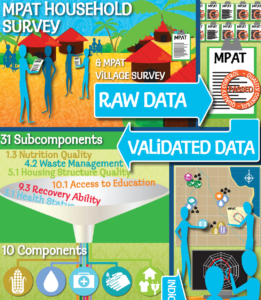 Abstract/Summary: The Multidimensional Poverty Assessment Tool (MPAT) provides data that can inform all levels of decision making by providing a clearer understanding of rural poverty at the household and village level. As a result, MPAT can significantly strengthen the planning, design, monitoring and evaluation of a project, and thereby contribute to rural poverty reduction.
Abstract/Summary: The Multidimensional Poverty Assessment Tool (MPAT) provides data that can inform all levels of decision making by providing a clearer understanding of rural poverty at the household and village level. As a result, MPAT can significantly strengthen the planning, design, monitoring and evaluation of a project, and thereby contribute to rural poverty reduction.
This brochure explains:
-
- What MPAT is
- How MPAT works
- When to use MPAT and why
- How to use MPAT
- What resources are available for implementing MPAT
The tool allows project managers, government officials, researchers and others to identify and monitor sectors that require support in order to reduce rural poverty and improve livelihoods. It also provides an objective means of justifying resource allocation or planning priorities. MPAT is based on a bottom-up, participatory approach that reflects communities’ voices, wants and perspectives.
PDF on Publisher Website | PDF on OSF
The Multidimensional Poverty Assessment Tool: User’s Guide
Authors: IFAD [Cohen, A. & Jayne, S.]
Publication Year: 2014 | Journal / Publisher: United Nations International Fund for Agricultural Development
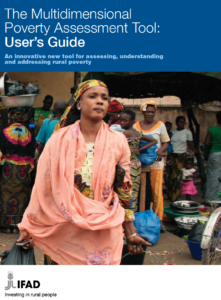 Abstract/Summary: The Multidimensional Poverty Assessment Tool (MPAT) provides a method for simplifying the complexity of rural poverty in order to support poverty alleviation efforts. MPAT uses thoroughly designed and tested purpose-built surveys to collect data on people’s perceptions about fundamental and interconnected aspects of their lives, livelihoods and environments. Standardized indicators, developed through a comprehensive participatory process, are then employed to combine, distil and present these data in an accessible way. MPAT was developed through a participatory, collaborative process based on expert feedback from dozens of international development experts from IFAD, other United Nations agencies, international and regional organizations, and universities from around the world. It was field-tested in countries in both Asia and Africa. In the pages that follow, we explain what MPAT is, how it works and how it is used, providing step-by-step instructions, training materials and other resources. The ultimate objective of this User’s Guide and the accompanying Excel Spreadsheet is to make MPAT a truly free and open-source tool, so that any institution or agency, big or small, may implement MPAT on its own.
Abstract/Summary: The Multidimensional Poverty Assessment Tool (MPAT) provides a method for simplifying the complexity of rural poverty in order to support poverty alleviation efforts. MPAT uses thoroughly designed and tested purpose-built surveys to collect data on people’s perceptions about fundamental and interconnected aspects of their lives, livelihoods and environments. Standardized indicators, developed through a comprehensive participatory process, are then employed to combine, distil and present these data in an accessible way. MPAT was developed through a participatory, collaborative process based on expert feedback from dozens of international development experts from IFAD, other United Nations agencies, international and regional organizations, and universities from around the world. It was field-tested in countries in both Asia and Africa. In the pages that follow, we explain what MPAT is, how it works and how it is used, providing step-by-step instructions, training materials and other resources. The ultimate objective of this User’s Guide and the accompanying Excel Spreadsheet is to make MPAT a truly free and open-source tool, so that any institution or agency, big or small, may implement MPAT on its own.
PDF on Publisher Website | PDF on OSF
The Multidimensional Poverty Assessment Tool: A new framework for measuring rural poverty.
Authors: Cohen, A.
Publication Year: 2010 | Journal / Publisher: Development in Practice
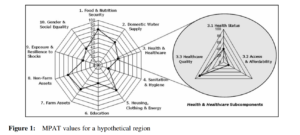 The Multidimensional Poverty Assessment Tool (MPAT) measures fundamental dimensions of rural poverty in order to support poverty-alleviation efforts in the less developed world. This article’s primary purpose is to introduce MPAT and describe its theoretical rationale. It begins with an overview of the importance of creating enabling environments for rural poverty alleviation before describing MPAT’s purpose and structure. The article goes on to address some of the advantages and shortcomings of surveys and indicators as means of measuring poverty, and concludes with a few caveats on using MPAT, and a focus on its added value to practitioners and academics.
The Multidimensional Poverty Assessment Tool (MPAT) measures fundamental dimensions of rural poverty in order to support poverty-alleviation efforts in the less developed world. This article’s primary purpose is to introduce MPAT and describe its theoretical rationale. It begins with an overview of the importance of creating enabling environments for rural poverty alleviation before describing MPAT’s purpose and structure. The article goes on to address some of the advantages and shortcomings of surveys and indicators as means of measuring poverty, and concludes with a few caveats on using MPAT, and a focus on its added value to practitioners and academics.
PDF on Publisher Website | PDF on OSF
Water & poverty in rural China: Developing an instrument to assess the multiple dimensions of water & poverty
Authors: Cohen, A. & Sullivan, C.
Publication Year: 2010 | Journal / Publisher: Ecological Economics
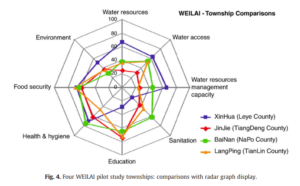 Abstract/Summary: This paper describes the theoretical foundations and development of a multidimensional, water-focused, thematic indicator of rural poverty: The Water, Economy, Investment and Learning Assessment Indicator (WEILAI). The WEILAI approach was specifically designed for application in rural China, to support poverty alleviation project planning, monitoring and evaluation, as well as targeting and prioritization. WEILAI builds primarily on the basic needs framework of poverty alleviation, and on the methodological structure of the Water Poverty Index, to provide a proxy measure of an area’s poverty by assessing eight key poverty sectors, with a strong focus on the components of water-poverty. The WEILAI approach was piloted and implemented in 534 households in China’s mountainous southwest. This paper describes the indicator construction, weighting schemes, methodology, field sites, and statistical validation of the results. In addition, we discuss the results, feedback from in-country project staff, and the likely utility of the tool for project planning, monitoring and evaluation support. The paper concludes with a discussion of WEILAI’s overall utility and ongoing development.
Abstract/Summary: This paper describes the theoretical foundations and development of a multidimensional, water-focused, thematic indicator of rural poverty: The Water, Economy, Investment and Learning Assessment Indicator (WEILAI). The WEILAI approach was specifically designed for application in rural China, to support poverty alleviation project planning, monitoring and evaluation, as well as targeting and prioritization. WEILAI builds primarily on the basic needs framework of poverty alleviation, and on the methodological structure of the Water Poverty Index, to provide a proxy measure of an area’s poverty by assessing eight key poverty sectors, with a strong focus on the components of water-poverty. The WEILAI approach was piloted and implemented in 534 households in China’s mountainous southwest. This paper describes the indicator construction, weighting schemes, methodology, field sites, and statistical validation of the results. In addition, we discuss the results, feedback from in-country project staff, and the likely utility of the tool for project planning, monitoring and evaluation support. The paper concludes with a discussion of WEILAI’s overall utility and ongoing development.
PDF on Publisher Website | PDF on OSF
The Multidimensional Poverty Assessment Tool: Design, development & application of a new framework for measuring rural poverty
Authors: Cohen, A.
Publication Year: 2009 | Journal / Publisher: United Nations International Fund for Agricultural Development
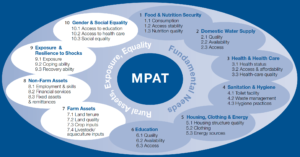 Abstract/Summary: The purpose of this book is to describe the theoretical foundations upon which the Multidimensional Poverty Assessment Tool (MPAT) was built, to tell the story of how it was created, developed, tested and piloted in rural China and India, and to explain how MPAT can be used to benefit rural communities around the world. Lasting poverty alleviation is achieved by fostering a comprehensive enabling environment within which people have a sufficiently high level of well-being and are able to pursue their livelihood goals based on their aspirations and initiative. To ensure that such environments are in place requires, at a minimum, an understanding of the key constraints rural people face – the fundamental dimensions central to their lives and livelihoods. MPAT does not try to define rural poverty per se; rather it takes a step back from assessment modalities that are overly focused on economic- and consumption-oriented indicators and strives to provide an overview of fundamental and relatively universal dimensions germane to rural livelihoods, rural life, and thus to rural poverty. By summarizing rural communities’ perceptions about key dimensions of rural poverty and focusing them through a quantitative lens, MPAT transparently illuminates problem areas so that all stakeholders can see where deficiencies lie and can begin to discuss which interventions may be most appropriate to address them, based on the local context.
Abstract/Summary: The purpose of this book is to describe the theoretical foundations upon which the Multidimensional Poverty Assessment Tool (MPAT) was built, to tell the story of how it was created, developed, tested and piloted in rural China and India, and to explain how MPAT can be used to benefit rural communities around the world. Lasting poverty alleviation is achieved by fostering a comprehensive enabling environment within which people have a sufficiently high level of well-being and are able to pursue their livelihood goals based on their aspirations and initiative. To ensure that such environments are in place requires, at a minimum, an understanding of the key constraints rural people face – the fundamental dimensions central to their lives and livelihoods. MPAT does not try to define rural poverty per se; rather it takes a step back from assessment modalities that are overly focused on economic- and consumption-oriented indicators and strives to provide an overview of fundamental and relatively universal dimensions germane to rural livelihoods, rural life, and thus to rural poverty. By summarizing rural communities’ perceptions about key dimensions of rural poverty and focusing them through a quantitative lens, MPAT transparently illuminates problem areas so that all stakeholders can see where deficiencies lie and can begin to discuss which interventions may be most appropriate to address them, based on the local context.
PDF on Publisher Website | PDF on OSF
The Rural Water Livelihoods Index. Working Paper
Authors: Sullivan, C., Cohen, A., Faurès, J. M., & Santini, G.
Publication Year: 2008 | Journal / Publisher: Food & Agriculture Organization of the United Nations
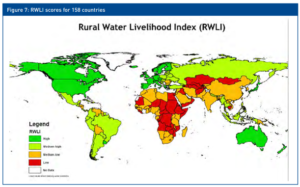 Abstract/Summary: The Rural Water Livelihood Index (RWLI) is calculated on the basis of components and indicator values representing each of these four dimensions. The resulting composite index reflects the values for these four dimensions, and on this basis, judgements can be made on how water management might be improved. Each of the four dimensions (components) of the RWLI are represented by two subcomponents, which are combined using a weighted average. In this report, this framework is applied at the national scale, but the approach can be used at any scale as long as appropriate data is available. The purpose of the RWLI is to provide policy makers and planners at the national level an overview of where their country stands relative to others (much like the Human Development Index), and relative to themselves over time, to examine and monitor progress being made as a result of actions taken. This in turn will hopefully allow for better targeted water related interventions to improve rural livelihoods. Through the measurement of these key components, it will be possible to assess which of the four dimensions are most likely to benefit from interventions. Appropriate interventions are context-specific and will have to be identified on a country-by-country basis since contexts differ so widely (i.e., responses to address the reported states will be country and site-specific). However, a general Response Matrix is being developed to provide planners and policy makers a conceptual framework to guide this process and at a macro-level the index values help national-level planners identify which sectors might be most in need of assistance.
Abstract/Summary: The Rural Water Livelihood Index (RWLI) is calculated on the basis of components and indicator values representing each of these four dimensions. The resulting composite index reflects the values for these four dimensions, and on this basis, judgements can be made on how water management might be improved. Each of the four dimensions (components) of the RWLI are represented by two subcomponents, which are combined using a weighted average. In this report, this framework is applied at the national scale, but the approach can be used at any scale as long as appropriate data is available. The purpose of the RWLI is to provide policy makers and planners at the national level an overview of where their country stands relative to others (much like the Human Development Index), and relative to themselves over time, to examine and monitor progress being made as a result of actions taken. This in turn will hopefully allow for better targeted water related interventions to improve rural livelihoods. Through the measurement of these key components, it will be possible to assess which of the four dimensions are most likely to benefit from interventions. Appropriate interventions are context-specific and will have to be identified on a country-by-country basis since contexts differ so widely (i.e., responses to address the reported states will be country and site-specific). However, a general Response Matrix is being developed to provide planners and policy makers a conceptual framework to guide this process and at a macro-level the index values help national-level planners identify which sectors might be most in need of assistance.
PDF on Publisher Website | PDF on OSF

